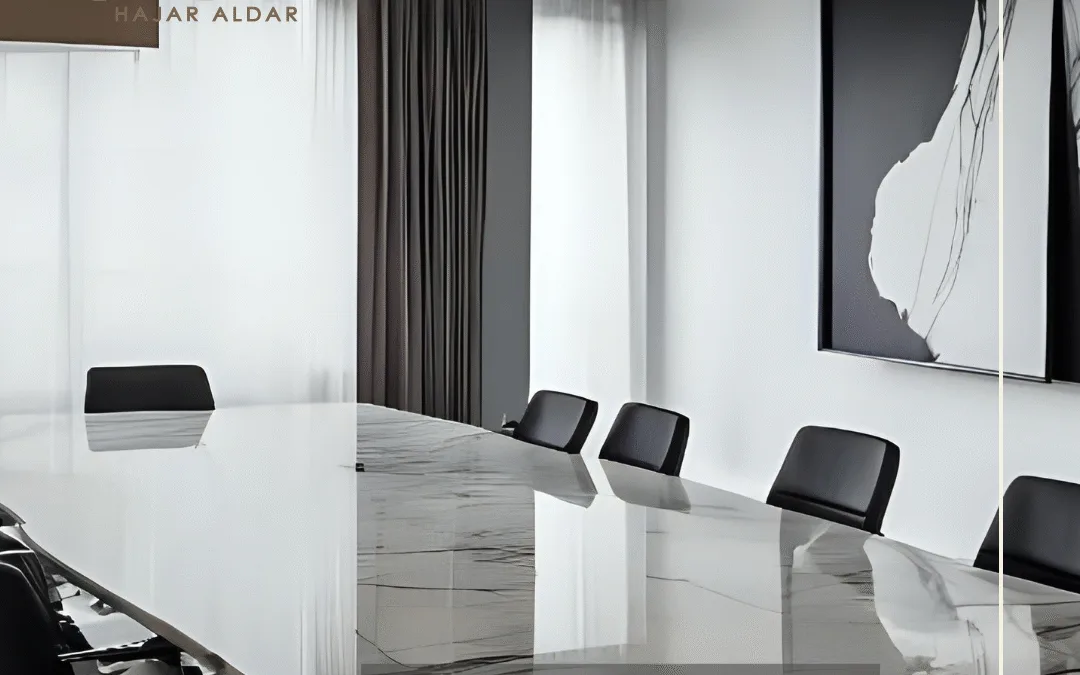Marble in Modern Meeting Rooms: Elegance that Enhances Decisions
Introduction
Meeting rooms are no longer just spaces for holding meetings or making decisions; they have become a reflection of an institution’s identity and demonstrate the level of professionalism and sophistication it embodies. For this reason, designers pay great attention to selecting the materials that dominate these spaces. Leading among these materials is marble, with its luxurious texture and elegant appearance, playing a pivotal role in the design of modern meeting rooms, both aesthetically and functionally.
In this article, we explore the importance of marble in meeting rooms, how to smartly incorporate it into interior design, and the benefits it offers beyond appearance to include comfort, durability, and institutional impression.
Marble… More Than Just Beauty
Marble has long been associated with luxury and history, but in modern meeting rooms, it is redefined to serve deeper purposes:
Emphasizing seriousness and professionalism
Enhancing trust and first impressions
Creating a visual link between luxury and modern technology
Where Can Marble Be Used in the Meeting Room?
Main Meeting Table
A natural marble table (such as Calacatta or Emperador) serves as the room’s centerpiece.
It can be combined with modern metal bases to reflect an industrial contemporary style.
The marble table imparts a sense of weight and confidence to the space.
Back Walls or Presentation Wall
Installing marble panels behind the display screen or digital whiteboard.
Some designers use backlit marble to highlight the wall dramatically.
Luxurious Flooring
Matte marble in calm colors enhances the room’s tranquility and provides formal elegance.
Simple geometric patterns using multiple marble pieces add a design touch without visual clutter.
Suitable Colors for Meeting Rooms
In professional environments, bold or loud colors are generally avoided; instead, neutral marble tones are preferred:
White with gray veins: adds spaciousness and natural lighting.
Dark gray or charcoal: reflects seriousness and reduces visual distraction.
Beige or creamy: warm and neutral, fitting balanced work environments.
Practical Benefits of Marble in Meeting Rooms
Durability under heavy use: Meeting rooms are used daily by teams and visitors, so floors and tables need to withstand continuous pressure, which marble’s toughness provides.
Ease of maintenance: Polished marble requires minimal cleaning effort, maintaining its glossy appearance—ideal for institutions reliant on visual impressions.
Natural sound insulation: Marble, when combined with wood or gypsum in the design, helps reduce sound echo inside the room, enhancing communication quality.
Technology integration: Modern marble tables can integrate wireless charging systems, HDMI ports, or built-in sound systems without compromising marble’s beauty.
Marble as an Element of Corporate Identity
Marble is no longer just décor; it is a means for companies to express their identity:
Major financial institutions rely on marble to convey trust and solidity.
Tech companies use white or gray marble to associate with modernity and intelligence.
Legal and consulting offices combine marble with dark wood to emphasize tradition and professionalism.
Attention to Details
In marble-based meeting rooms, meticulous details are often considered:
Table edges designed with curves or sharp geometric angles.
Electrical outlets seamlessly integrated into the table surface.
Under-table or under-wall marble lighting to enhance the upscale atmosphere.
Challenges to Consider
Despite its advantages, using marble in meeting rooms requires attention to certain points:
Heavy weight: Requires a strong support structure, especially for large tables.
Susceptibility to stains: Especially from coffee or acidic substances, so it must be treated with a protective sealant.
Reflections: Glossy marble may reflect light intensely, disturbing some attendees; hence, matte finishes are preferred in some cases.
Real-World Examples: How Marble Is Used in Modern Designs
A global tech company in Dubai used a matte black marble meeting table with a bookmatch pattern, equipped with hidden LED lighting on both sides.
A law firm in London employed white marble panels with warm lighting behind the presentation area.
A financial institution in Riyadh combined marble with dark wooden walls and gray marble flooring to create a formal yet comfortable environment.
Conclusion
Marble in modern meeting rooms is more than just a décor choice; it is a silent statement about the place’s identity and values. Its luxurious appearance, refined texture, and practical strength make it an exceptional material capable of giving the meeting room an unforgettable presence. When combined with modern lighting and design techniques, marble becomes a tool to inspire attendees, stimulate focus, and elevate institutional status.
If you are considering renovating your meeting room, make marble a priority… it doesn’t just create a table around which people gather—it creates an environment where decisions are built.


